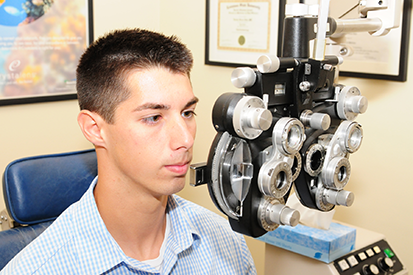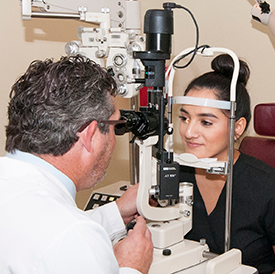 Professional eye care begins with a
Professional eye care begins with a
professional eye exam.
Eye exams are very important to maintain the overall health of your eyes. They are designed to determine how well light rays are focused on the retina. Eye doctors are specially trained to check for, recognize and treat eye conditions and diseases. We recommend you have a yearly eye exam by your eye doctor. If you wear contact lenses, be sure to inform your eye doctor when scheduling your appointment, as additional time will be needed to measure your eye’s surface and fit your contact lenses.
There are a number of tests that your eye doctor may conduct during your normal routine eye exam to ensure your vision is at its best. Some of these tests include:
-
Visual Acuity Test: A Visual Acuity Test is a routine part of an eye examination performed to determine the smallest letters a patient can read on a standardized chart that is 20 feet away. You will be asked to remove your contact lenses or glasses and gently cover one eye with the palm of your hand while reading aloud the smallest line of letters you can read on the chart. The test is performed on each eye, one at a time.
 Our eye exams are thorough assuring that your lens or contacts prescription produces your best eye sight. Exam appointments now available.
Our eye exams are thorough assuring that your lens or contacts prescription produces your best eye sight. Exam appointments now available.
Your visual acuity will be expressed in a fraction. The top number represents the distance you stand from the chart, while the bottom number represents the distance at which a person with normal eyesight could read the same line you read correctly. For example, normal vision is considered 20/20. If your visual acuity is 20/40, then this indicates that the line that you correctly read at 20 feet can be read by a person with normal vision from 40 feet away.
-
Visual Field Test: A Visual Field Test will allow your eye doctor to see the full horizontal and vertical range of what you are able to see peripherally. They determine the potential of blind spots (scotomas) occurring, which could indicate eye diseases.
A Confrontation Visual Field Test is the most common type of field test used by eye doctors. You will be asked to cover one eye while focusing on a specific target object, such as the doctor, and then you will be asked to describe images in his/her peripheral vision. If an eye disease is suspected, further comprehensive, more formal types of tests may be required.
-
Refraction Assessment: A refraction assessment helps your eye doctor determine the most accurate corrective lens prescription that will give you the best possible vision. You will be asked to look through a Phoroptor, a mask-like device that contains different lenses, which will help determine the best combination that will give you the sharpest vision.
-
Retinoscopy: A retinoscopy test will usually be performed early in the eye exam so the eye doctor can determine an approximate prescription from which to start. With the room’s lights dim, you will be asked to look through a machine and focus on a large target (usually the big “E” on the chart). Your doctor will shine a light in your eye and flip lenses on the machine. Based on the how the light reflects on your retina, the doctor will be able to calculate your refractive error.
-
Autorefractor Testing: An autorefractor is sometimes used by doctors to determine a patient’s prescription. A chin rest will help stabilize your head while you look at a pinpoint of light. It is used to evaluate the way your retina focuses an image. Autorefractors are commonly used in evaluating children’s eyes.
-
Slit-Lamp Examination: A slit-lamp examination uses a microscope with a light attached, which allows the eye doctor to examine the structures at the front of the eye (cornea, iris and lens) under high magnification. Some patients may have to have their eyes dilated, allowing for a more efficient examination.
-
Glaucoma Testing: Glaucoma tests are performed to measure the pressure inside your eye. While there are a few variations of glaucoma tests, the most commonly used method today is Applanation Tonometry. This method of taking pressure involves contacting an anesthetized cornea with a tip to determine the eyes resistance or the pressure needed to flatten the cornea. The three most common methods of Applanation Tonometry are the Goldman Tonometer (performed using a slit lamp), the Perkins Tonometer and the Tono-pen. Both the Perkins and the Tono-pen are portable, making them ideal for patients with limited mobility.